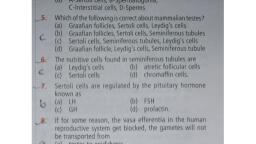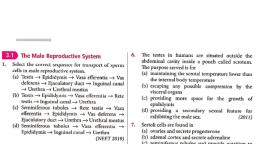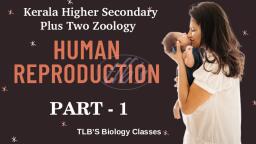Page 1 :
Science Test, , Q1. Reproduction is essential for living organisms in order to .........., , , , a) Keep the individual organism alive, , b) Fulfill their energy requirement, , c) Maintain growth, , d) Continue the species generation after generation, , Q2. The male reproductive parts of a flower, the stamens, are collectively known as, a) Androecium, , b) Filament, , c) Anther, , d) Gynoecium, , Q3. Which of the following diseases is transmitted sexually?, a) Kala Azar, , b) Jaundice, , c) Cholera, , d) Syphilis, , Q4. IUCD is for, , a) Vegetative propagation, , b) Contraception, , c) Increasing fertility, , d) Avoiding miscarriage, , Q5. Which among the following is not the function of testes at puberty?, (i) Formation of germ cells, , (ii) Secretion of testosterone, , (iii) Development of placenta
Page 2 :
(iv) Secretion of estrogen, , a) (i) and(ii), , b) (ii) and(iii), , c) (iii) and(iv), , d) (i) and(iv), , Q6. The correct sequence of organs in the male reproductive system for transport of sperms is, a) Testis — vas deferens — urethra, , b) Testis = ureter — urethra, , c) Testis — urethra — ureter, , d) Testis = vas deferens — ureter, , Q7. A population of thermophilic archaebacteria are generally found in hot springs. Any change, to the temperature of the water affects the survival of the archaebacteria. If the temperature of, hot springs gets reduced, change in which component can allow survival of few members of, these archaebacteria?, , a) cell wall, , b) cytoplasm, c) DNA, , d) ribosomes, , Q8. A small portion of oviducts of a woman is removed by surgical operation and the cut ends, are ligated is, , a) copperT, , b) Tubectomy, , c) Vasectomy, , d) Diaphragm, , Q9. What can be concluded about the division in plasmodium?, a) The cyst divides repeatedly to form many daughter cells., , b) The cell divides multiple times giving rise to many daughter cells.
Page 3 :
c) The nucleus divides repeatedly inside the cell to form new daughter cells., , d) The cyst enlarges in size and then bursts producing many new daughter cells., Q10. How do spores develop into Rhizopus?, , a) spores divide and grow into new individual, , b) spores combine with other spores and grow, , Cc) spores enlarge in size for the growth of new individual, , d) spores land on other organisms and increase with their growth in size, , Q11. The image shows the structure of a flower., , , , Which process will likely be disturbed or not occur, if the labelled part is removed from the, flower?, , a) formation of fruit, , b) transport of pollen, , c) formation of pollen, , d) development of pollen tube, , Q12. Which event will likely occur in the ovaries of females after attaining puberty?, a) fertilisation, , b) synthesis of eggs, , Cc) production of eggs, , d) growth and development of embryo, , Q13. Which option correctly shows the path that the sperms take when they are released from, the male reproductive system?
Page 4 :
(a) testis ureter — urethra — penis, , (b) testis — vas deferens — ureter — penis, (c) testis . ureter vas deferens — penis, (d) testis . vas deferens = urethra — penis, , Q14. Offsprings formed by asexual method of reproduction have greater similarity among, themselves because., , , , a) Asexual reproduction involves two parent, , b) Asexual reproduction does not involve gametes, , c) Asexual reproduction occurs before sexual reproduction, , d) Asexual reproduction occurs before sexual reproduction, , Q15. Length of the pollen grain depends upon the distance between, a) pollen grain and upper surface of stigma, , b) pollen grain on upper surface of stigma and ovule, , c) pollen grain in anther and upper surface of stigma, , d) upper surface of stigma and lower part of style, , Q16. Name the parts labelled A, B, C, D and E., , A, , (b) Where do the following functions occur?, (i) Production of an egg, (ii) Fertilisation, , (iii) Implantation of zygote.
Page 5 :
Q17. The male reproductive system consist of portions which produce the germ-cells and other, portions that deliver the germ-cells to the site of fertilisation. Testes are located outside the, abdominal cavity in scrotum because sperm formation requires a lower temperature than, normal, , body temperature. It also has a role of secretion of male sex hormone which brings changes in, appearance seen in boys at the time of puberty. Vas deferens unites with a tube coming from, urinary bladder. Urethra is a common passage for sperms and urine. Prostate gland and, seminal vesicles add their secretions so that sperms are now in fluid., , Seminal vesicle, , is, ( \, Vas deferens—| ; } ‘Urethra, , Human-male reproductive system, , , , , (i) Name the sex hormone associated with males., , (a) Testosterone, , (b) Progesterone, , (c) Oestrogen, , (d) None of these, , (ii) Which of the following statements is incorrect ?, , (a) Sperms are present in a fluid, , (b) Fluid provides nutrition to sperms, , (c) Fluid makes easier transportation of sperms, , (d) Fluid helps to bind the sperms together, , (iii) Testes are located outside the abdominal cavity in scrotum because, , (a) sperms formation requires higher temperature than body temperature, (b) sperms formation requires lower temperature than body temperature, , (c) it is easier to transport sperms from the scrotum















































